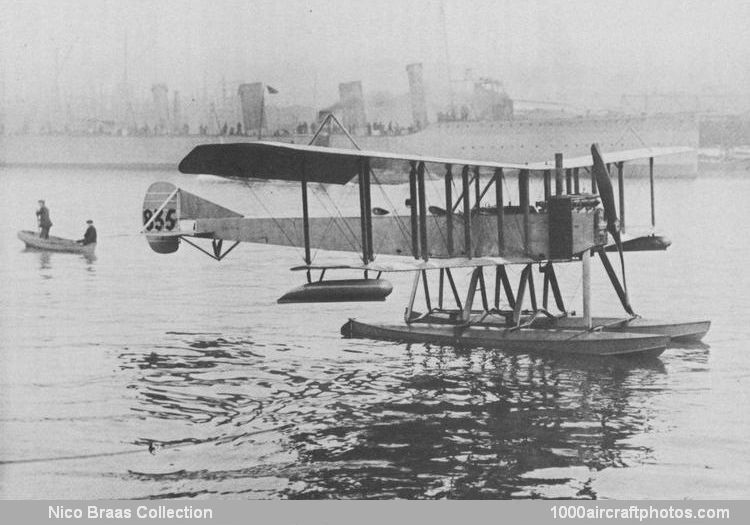Owing to the unpopularity of the pusher Navy planes with RNAS pilots, who found them difficult to control, White's were asked to design and build a tractor torpedo reconnaissance seaplane. They agreed to do so as soon as their additional workshop space was completed. An initial contract was awarded for six machines (serialed 835 to 840) and construction commenced in the autumn of 1914; shortly afterwards a further contract was given for the construction of an additional twenty-four seaplanes (serialed 1300 to 1319, 1351 to 1354).
The original six machines were allocated to seaplane stations on November 6: two to Grain, two to Felixstowe, and one each to Killingholm and Yarmouth. They were intended for defensive purposes only, against raiding cruisers or transports of a possible invasion force. However, delays with the new Sunbeam engines caused the completion date to be extended and the prototype was not ready until March 1915. After initial trials at Cowes with Eric Gordon England at the controls, it was flown to Calshot for its official Service trials towards the end of May. Its airworthiness was reported to be 'very good', and its seaworthiness was described as 'good'.
By this time it was known as the Admiralty Type 840 Seaplane, this being taken from the serial number of the final machine of the first batch. It emerged as a two-seater tractor biplane with four-bay untapered folding wings, a low-set rectangular tail plane at the end of a long thin fuselage and a single strut-braced fin and rudder. The upper wing was of greater span than the lower and the overhang was braced to triangular kingposts; long single-acting ailerons were fitted to the upper wing only.
The engine was a 225 hp Sunbeam, driving a two-bladed propeller and cooled by a pair of radiators mounted one on each side of the fuselage in line with the leading edge of the wings.
The long twin floats had three steps and rudders and were attached to the fuselage by a complicated arrangement of struts - a torpedo, if carried, was attached to the curved cross braces between the floats. Small cylindrical floats were attached to each lower wing tip by means of four short struts. On later machines the length of the struts to the floats was increased and the curved cross-braces between the floats were replaced by straight ones.
Although not usually carried, a Lewis machine gun could be fitted to a pivot mounting in the rear cockpit. Alternatively a double-barrel shot gun could be carried. This little-known gun, named Paradox, was designed by Holland & Holland, with the last few inches of the barrels rifled at the muzzle end. This imparted a spin to the ball ammunition which was used and improved the effective range. They could also fire chain-shot. The first heavy bombs to be carried by British aircraft were fitted to Short 184s and Wight 840s. Carriers for two 112 lb (51 kg) bombs were held by tubular supports between the floats and the underside of the fuselage. Alternatively three 65 lb (29 kg) bombs or one 14 in (35.56 cm) torpedo of 810 lb (367 kg) could be carried.
In 1915 White's were asked if they could build further aircraft of this type and were offered contracts for an additional fifty-two machines. However, they were by now fully occupied in building aircraft, and they were forced to decline the contracts. By this time, the Admiralty had decided that two Seaplane stations in Scotland – Dundee and Scapa – should be equipped with White 840 Seaplanes and therefore the sensible decision was made to award a contract for thirty-two machines (serialed 1400 to 1411, 9021 to 9040) to Beardmore of Dalmuir. Of these, only twenty were actually completed and the remaining twelve were delivered as spares. On August 6, 1915, a further twenty machines (serialed 8281 to 8292, 8542 to 8549) were ordered from Portholme Aerodrome Ltd., of Huntingdon.
The 840 Seaplanes had an undistinguished career and gained no battle honors, but for more than a year they carried out an enormous number of reconnaissance and anti-submarine patrols over the Channel and the North Sea and formed the main equipment of the Seaplane Stations at Scapa, Dundee, Calshot and Gibraltar, and also of the seaplane carrier Campania. They filled the gap between the motley collection of largely unsuitable reconnaissance aircraft with which the RNAS entered the war and the advent of more sophisticated machines, such as the Short 184s and the America Flying Boats. In addition to their more warlike activities, they were also quite widely used for the training of crews.
After the pictured prototype had completed part of its type and torpedo trials at Calshot April 26 and July 15, 1915, it was found to be potentially unsafe and was returned to Cowes for modification. It eventually passed its final acceptance trials at Cowes on July 29 and was shipped to Scapa on the merchant vessel Somersby. There it joined the three Wight 840s (836, 837 and 838) already based on the seaplane-carrier Campania. On June 12, 1916, the aircraft was struck off charge."
Span: upper 61 ft 0 in (18.59 m); folded 12 ft 2 in (3.71 m)
Span: lower 46 ft 0 in (14.02 m)
Length: 41 ft 0 in (12.50 m)
Height: 14 ft 4 in (4.37 m)
Wing chord: 5 ft 6 in (1.68 m)
Wing area: 568 sq.ft (52.77 sq.m)
Tail plane span: 12 ft 0 in (3.66 m)
Tail plane chord: 5 ft 10 in (1.52 m)
Propeller diameter: 11 ft 6 in (3.51 m) or 11 ft 0 in (3.35 m)
Empty weight: 3,408 lb (1,546 kg)
Loaded weight: 4,453 lb (2,020 kg)
Max speed: 75 mph (121 kmh)
Cruise speed: 69 mph (111 kmh)
Climb: to 3,000 ft (914 m) 16 min
Climb: to 6,500 ft (1,981 m) 30 min
Range: 300 mls (483 km)
Endurance: 7 hr 0 min
